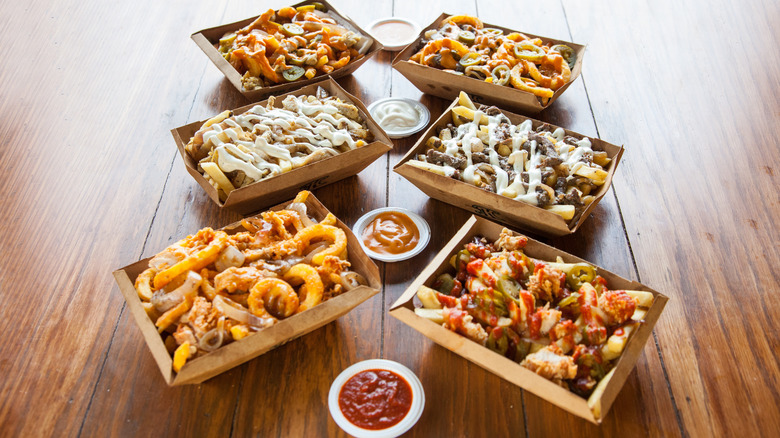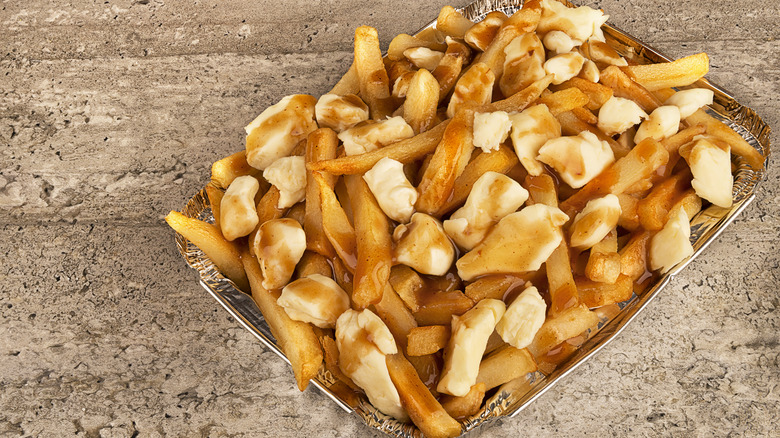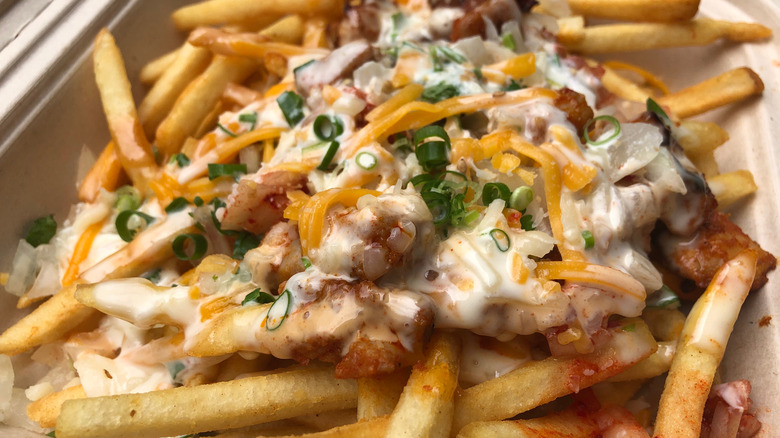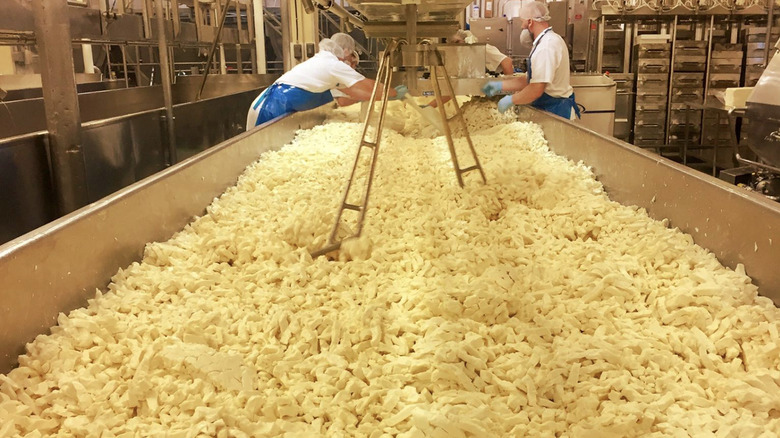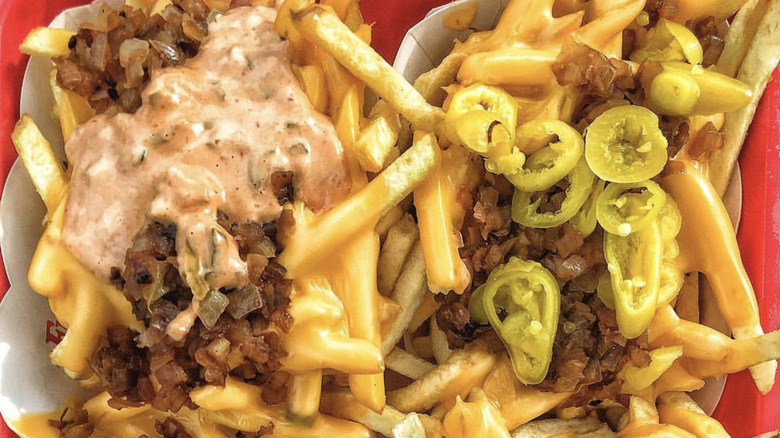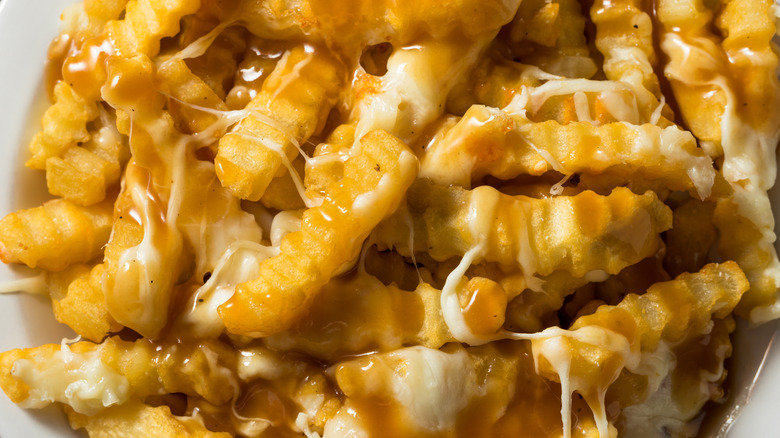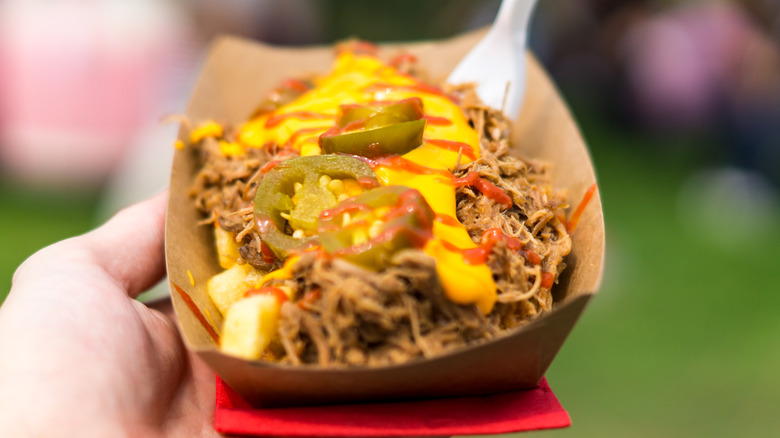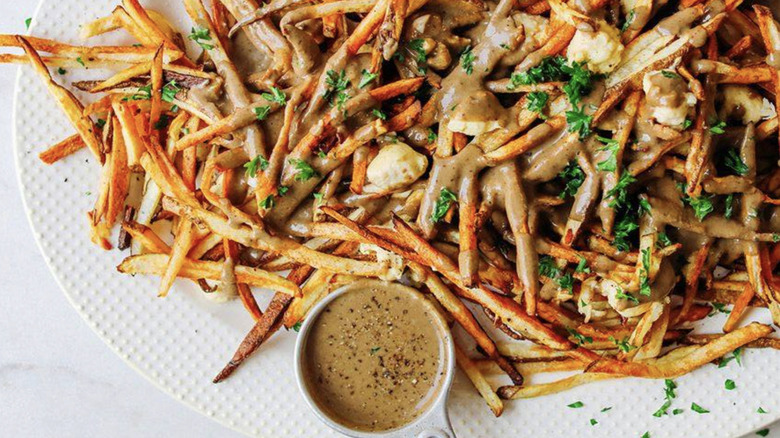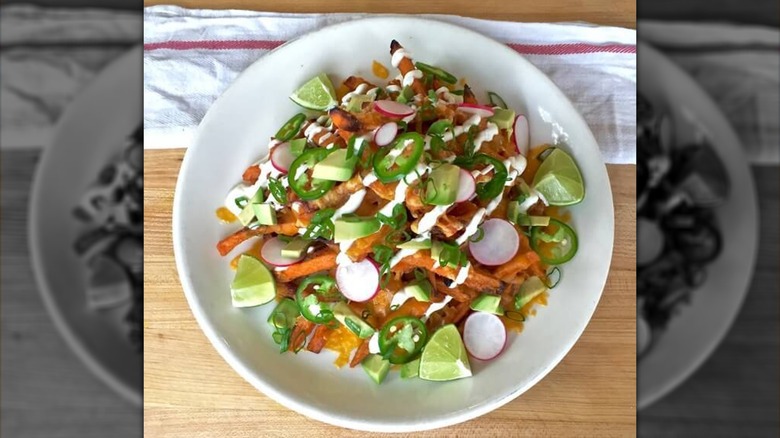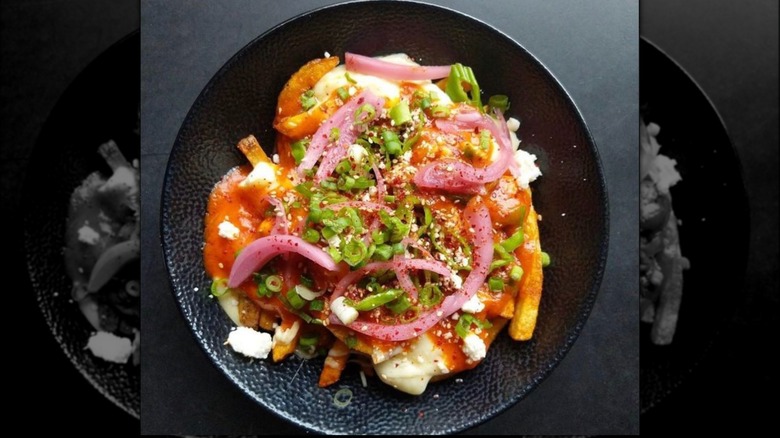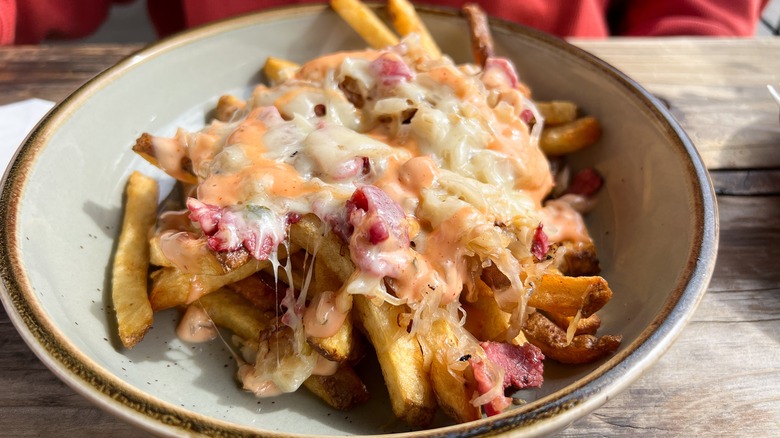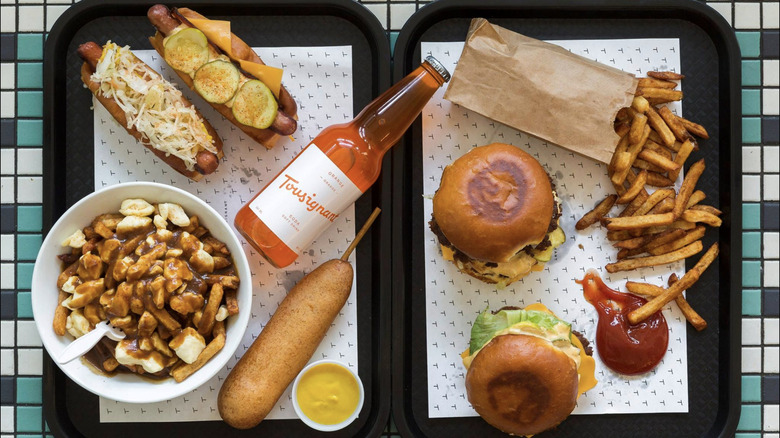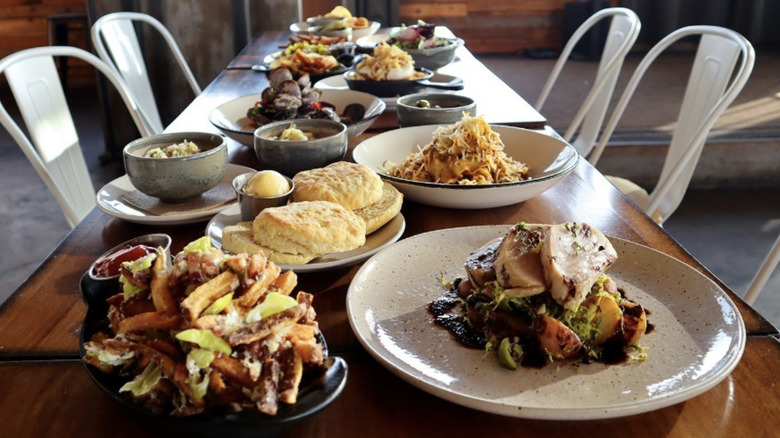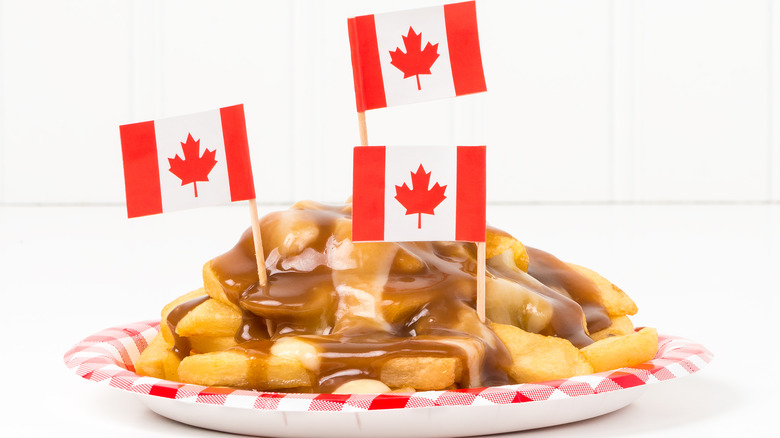Poutine Vs Loaded Fries: Everything You Need To Know
French fries. Maybe they're French or perhaps they're Belgian, but french fries are a true international food because they offer limitless possibilities as a vehicle of taste and culinary creativity. Two of the most famous fry-based dishes are poutine and loaded fries. Poutine has carved out a ubiquitous cultural identity — the dish began in Québec, Canada, stormed most of the world, and welcomed some noteworthy interpretations along the way. Loaded fries, however, have taken a more fluid path. We're certain it's an American-born dish, but this pub and game day favorite contains ambiguous origins that allow room for abundant creativity — with mixed results.
If you're a tad perplexed about the ins and outs of poutine vs loaded fries, we're here to give you everything you need to know. We've examined the inner workings of what makes poutine's ingredients special (hint, it's regional), while also exploring how many parts of the world serve their versions of both poutine and loaded fries. It's hard to pit poutine and loaded fries against one another. Both feed us thoroughly and bring a high-low dichotomy to the dining world by way of cultural significance and mass market accessibility. This is how poutine and loaded fries stack up against each other.
What is poutine?
Poutine is a dish of french fries, cheese curds, and brown gravy from the French-Canadian province of Québec, Canada. Like many famous foods with humble beginnings (like french fries themselves and of course, the almighty hamburger), poutine's story isn't set in stone. By most accounts, poutine came about around 1957, in Warwick, Québec, a small rural town where Fernand Lachance and his wife owned Café Ideal (the eatery would later be renamed to Le Lutin qui rit). The restaurant was close to fromageries that produced cheese curds (these cheese shops were fixtures in Centre-du-Québec at the time) and Lachance noticed that customers often ordered a side of cheese curds with their fries.
As the story goes, a Café Ideal regular named Eddy Lainesse flipped the script when he asked if the cheese curds could be put directly onto the french fries. Upon hearing the request, Monsieur Lachance replied, "Ça va te faire une maudite poutine!" (Translation: "That will make a damned mess!") and served Lainesse his order in a paper bag (via Food Network). Word began to spread of Café Ideal's unique french fry customization and patrons were intrigued. Lachance later began serving his fries and cheese curds on plates, but customers found that the dish would become cold rather quickly. To keep the fries warmer longer, Lachance came up with the idea to pour gravy over the fries and curds; and thus, poutine was born.
What are loaded fries?
While poutine relies on a recipe rich in national tradition, the concept of loaded fries is brimming with interpretation. Like poutine, loaded fries' beginnings aren't so easy to pin down. To do the origin story of loaded fries justice, we must acknowledge the fry basket that most likely started it all: chili cheese fries.
Dairy Queen claims the invention of chili cheese fries and who are we to deny it? Even so, exactly who this Dairy Queen savant is remains a matter of debate. Some say Austin Ruse, a Dairy Queen employee in Missouri was the first to serve chili cheese fries through the takeout window, offering them as a specialty item. Others maintain that 16-year-old Don Jenkins who worked at a Dairy Queen in Tomball, Texas came up with the original version on his lunch break. A third story credits two waitresses at Hefty's Coney Island in Michigan with creating the dish — the restaurant still exists, but doesn't publicly take credit for inventing chili cheese fries.
That said, Dairy Queen (or maybe Hefty's Coney Island) walked so that loaded fries could run. Loaded fries have become not just a go-to pub staple, but an opportunity for chefs to put their spin on an American fast food classic. At its heart, loaded fries are similar to poutine in that the inspiration came from an experiment. Remarkable still is both dishes' endurance as french fry concoctions that have permanently won the world over.
For authentic poutine, go north
The distinguishing mark of poutine is the cheese curds that are generously sprinkled over the fries before being drizzled with gravy. It's what makes poutine such a unique french fry dish, and it's also what makes it very regional — which means you can't find authentic poutine just anywhere.
Cheese curds are a true delicacy in Québec. These unaged chunks of cheddar are taken straight from the cheese vat so they do not undergo the full cheddaring process. Fresh cheese curds are airy, springy, and full of whey, giving them a trademark squeak when you take a bite. That squeak is what makes the cheese curds in a quality plate of Québécois poutine unlike anywhere else in the world. Fresh Canadian cheese curds will typically retain their squeak for about a day. After that, they inevitably age (and legally require refrigeration) which causes them to take on a harder texture.
Québec's thriving cheese industry allows the province easy access to the freshest cheese curds, but there are areas in the U.S. that produce some fine cheese curds as well. Naturally, Wisconsin is one such place – the state produces more than a quarter of the cheese made in the country. Upstate New York has its share of top-notch cheesemongers as well. Producing cheese curds is a delicate art that is most prominent in rural areas of North America, where the climate is better for dairy farming.
Not all loaded fries are created equal
Loaded fries and poutine are definitive bar snacks, but loaded fries in particular have a lot of prominence on fast food menus too. You could pull up to several drive-thrus right now and order loaded fries — though some places do it better than others.
Shake Shack is known for its crispy crinkle-cut fries, which can be topped with cheese sauce and applewood-smoked bacon to make for a more indulgent side (it also happens to be a customer favorite). In-N-Out fans know that ordering your food Animal Style means adding melted cheese, grilled onions, and the chain's secret sauce. Animal-style fries are by no means diet food, but they're one of the most popular picks on the menu. If you're looking to order chili cheese fries from the place that (allegedly) started the loaded fries craze decades ago, Dairy Queen no longer keeps them on its standard menu. Instead, consider satisfying your craving at Checker's where the seasoned fries topped with meaty chili and melty cheddar cheese are a crowd-pleaser.
On the other hand, certain fast food restaurants are serving loaded fries that leave room for improvement. Wendy's Baconator Fries, for example, are perpetually soggy and overall unspecial. Meanwhile, White Castle's loaded fries suffer from heavy-handed doses of cheese sauce, bacon, and ranch dressing.
Fusion fries: how poutine and loaded fries have evolved
In the years after Fernand Lachance created his famous poutine at Café Ideal, the dish began to spread throughout the province, up to Québec City in 1969 and down to Montréal by 1983. In fact, Burger King locations in Canada still sell the dish as do Canadian McDonalds. As time went on, new spins on the original version of poutine popped up in the regions where the dish had become popular. Smoked meat was added in Québec, Mainers worked in fresh lobster, and Indian cooks who had emigrated to Canada created butter chicken poutine, a cultural fusion celebrating two distinct 1950s-era foods that are still widely popular today.
Meanwhile, loaded fries were also experiencing a regional renaissance. Carne Asada fries were born out of San Diego and are now all over the southwest, standing out as a true Mexican-American food. Greater Philadelphia claims pizza fries and New Jersey introduced the world to disco fries, a poutine-esque plate of french fries bathed in melted cheese and gravy that was meant for late nights.
Nowadays, restaurants everywhere toss the rule book and get imaginative when they decide to put poutine or loaded fries on the menu. White Rabbit Gastropub out of Frederick, Maryland serves a yummy crab poutine while Oregon's Potato Champion keeps Portland weird with its original creation of PBJ Fries, featuring peanut satay sauce and chipotle raspberry jam.
Which plate of fries wins the popularity contest?
Between poutine's distinguishing characteristics and loaded fries' freewheeling acceptance of eclectic toppings, one dish has proven to be more universal than the other. On the world stage, loaded fries edge out poutine in popularity because of the ease with which many nations can apply their culinary influences to the dish. We've seen some remarkable interpretations of poutine that seamlessly incorporate cross-cultural flavors in an impactful way (the aforementioned butter chicken poutine is a case in point), but it's not necessarily something that can be pulled off on a massive scale.
In that way, loaded fries act like a blank slate rife with possibility. The marinated, chopped skirt steak, guacamole, pico de gallo, cheese, and seasonings that make up Carne Asada fries took the U.S. by storm in the '90s inspiring countless food truck operations and becoming a mainstay at many Mexican restaurants in subsequent years.
At the same time, new incarnations of loaded fries are being served in cities from coast to coast. These highlight everything from Japanese and South Asian ingredients to house-made mornay sauce, and sweet churro fries tossed in cinnamon sugar and finished with squiggles of Bavarian cream.
Can you make a healthier version of poutine?
Meat gravy, cheese curds, and french fries fresh out of the deep fryer is poutine at its essence, but if you want to dabble in a taste of Québec without throwing caloric caution to the wind, you can. Poutine is a simple food that can be tweaked without completely sacrificing its traditional flavors.
Vegans aren't wrong to assume that their dietary restrictions exclude them from enjoying poutine, the original is not a vegan-friendly or even vegetarian-friendly dish, but a plants-only version does exist. For instance, Montréal's La Banquise, a locally famous 24-hour snack bar, offers 30 types of poutine — and vegan choices are on the list. Online recipes for vegan poutine are in no short supply either. Cashew cheese replaces authentic curds and items like soy sauce, dijon mustard, and vegetable broth come together to stand in for meat gravy.
Non-vegans who don't want to forgo those delectable cheese curds can include them and still get away with a healthier homemade poutine. Vitamin-rich sweet potato fries baked in the oven pair well with a vegetable or chicken broth-based gravy. Ingredients like scallions, cayenne pepper, parsley, or other herbs make the poutine zesty and don't tack on excess calories.
Loaded fries don't always have to be a calorie bomb
Anyone who has browsed the nutrition facts of fast food-loaded fries knows that the numbers are troubling at best. Wingstop's Louisianna Vodoo Fries are a cult favorite but a regular order means ingesting 680 calories, 38 grams of fat, 75 grams of carbohydrates, and 1,270 milligrams of sodium — ouch. Zaxby's Chicken Bacon Ranch Loaded Fries bring 1,270 calories to the table, along with 78 grams of fat, 88 grams of carbohydrates, and 3,070 milligrams of sodium.
Loaded fries are super customizable and simple to make at home, so it's easy to lighten the load. One way to do this is by approaching the fries' toppings as you would a salad. Use lean meat or veggie-based protein instead of bacon or full-fat chili (tempeh, ground turkey, or black beans work well), don't overdo the cheese, and top the plate with fresh scallions, avocado, tomatoes, or peppers. Or, go Mediterranean with feta cheese, beets, and hummus. For something more substantial (and Greek-inspired), layer a bed of fries with feta, red onion, olives, and shawarma beef or chicken. These alternatives bring the flavor without bogging down the fries with cheese sauce or ranch dressing.
You can also swap regular fries for sweet potato fries. Both potatoes stack up pretty evenly in the carbs department, but sweet potatoes are viewed as slightly healthier because they're packed with vitamin A and have a lower glycemic index, which is good for regulating blood sugar.
Where do people eat poutine?
At its core, poutine is a modest dish that was created in a modest, small-town café. As it gained steady popularity worldwide, attempts have been made to morph poutine into a fine dining plate. Renowned Montréal restaurant Au Pied de Cochon famously makes a poutine topped with foie gras, a controversial yet upscale delicacy.
Most of the time, you'll encounter poutine on bar or diner menus, at food trucks, or inside fusion forward eateries like Chicago's Kimski, a Korean, Polish, American hybrid that serves a poutine featuring kimchi beer gravy, Wisconsin cheddar curds, pickled red onion, scallions, and shishito peppers. It's also a fixture at Canadian fast-casual chain restaurants like Harvey's and New York Fries. Though the name betrays its Canadian-ness, New York Fries has expanded all over Canada and has many locations in the Middle East as well.
Europeans have embraced poutine's comforting goodness as well, with poutineries dotting the continent from England and Scotland, to Germany and the Czech Republic. In Hanoi, Vietnam The Moose & Roo Pub & Grill (it's a mashup of Canadian and Australian food) offers customers the option to "poutine any fries" by adding cheese and beef gravy (via TripAdvisor).
Where do people eat loaded fries?
American quick-service restaurants are at the heart of loaded fries' curious beginnings as well as their rise to international relevance. Pubs, street food stalls, movie theaters, diners, and the like are still the most likely places you'll encounter a plate of loaded fries. They're also a staple tailgating food, so if you're socializing on gameday loaded fries will probably be somewhere nearby.
Unlike poutine which requires some kind of gravy situation and a form of cheese, loaded fries aren't held to specific ingredient guidelines — they just need to be loaded up with toppings that go beyond a coating of store-bought sauces. Countries all over the world enjoy loaded fries, and depending on where you happen to be, loaded fries will look and taste a little different.
Loaded Reuben fries are piled with corned beef, sauerkraut, melted Swiss cheese, and drizzled with Russian dressing for a play on the iconic deli sandwich that epitomized 20th-century Jewish deli culture in urban America. Finland's take on loaded fries is called makkaraperunat (translation: sausage potatoes) and consists of french fries piled with not only sausage, but pickles, mayonnaise, onion, pickled cucumbers, ketchup, and mustard. Venture to Chile and get to know chorrillana, a heaping plate of fries stacked with sliced beef or pork, fried onions, and fried eggs that is popular in the nation's bars and cantinas as it's meant to be shared with friends.
Places to find the best poutine
Canada is the undisputed champion of poutine and if you're in the country and on a mission to wrap your hands (and taste buds) around a world-class take on the dish head to Montréal. Landmarks like the Montreal Pool Room have been fulfilling cravings since 1912 and count poutine as a house specialty. Chez Tousigant prides itself on hand-cut fries, scratch-made gravy, and the freshest cheese curds city folk can count on.
Taking things stateside presents a reworked approach yet still yields downright impressive results. The White Swan Public House in Seattle is a standout for its Poutine O' the Sea, which takes crispy french fries and lathers them with a chowder of fresh little neck clams and chowder flecked with bacon and scallions. Also not to be counted out is NYC's Mile End Deli. The straightforward nouveau diner-style restaurant sits on a quaint street in Brooklyn and is named for the artsy Montréal district. Most notably, Mile End Deli serves a traditional Québécois poutine. By boldly choosing not to riff on the iconic dish, Mile End Deli does poutine true justice.
Places to find the best loaded fries
Only in America can you feast on such diverse and complex portions of loaded fries. Nearly every state can lay claim to a killer loaded fries destination, but the top-ranked places earn praise for consistency and individuality alike.
South Street standby Ishkabibbles in Philadelphia has been breaking the mold since 1979. In addition to originating the Philly chicken cheesesteak, the fries here are not to be slept on. Pizza fries are a Philadelphian source of pride and Ishkabibbles retains that badge with its decadently sauced, thinly sliced pizza fries draped with a decadent crown of oregano and mozzarella cheese. Not ready to commit to all that, don't worry, Ishkabibbles' Spanish fries are equally praised, they're served with hot cherry peppers and onions.
Pickled Fish in Long Beach, Washington describes itself as a rustic, modern, and sustainable restaurant but when it introduced Dirty Dirty Fries to America, people didn't forget. Upgrading your fries by way of the Dirty Dirty slogan meant being treated to a helping of fried pork belly, pepperoncini, and goat cheese — a flawless upgrade made even more glorious thanks to a side of truffle ketchup. These days, Pickled Fish has cleaned up its act just a smidge by shortening its legendary appetizer to Dirty fries, although the truffle fondue, duck bacon, and fermented chili aioli that comes with it reminds us why this place had the greater 48 in a loaded fry chokehold not so long ago.
Methodology
We scoured through various historical accounts of poutine and loaded fries for this article. We also found bars, restaurants, and food trucks all over the globe that serve these dishes to this day — and read the reviews.
Our writer grew up eating poutine courtesy of her uncle who was raised in rural Québec and would bring home bags stuffed with real Canadian cheese curds from his trips up north (she also counts Montréal as one of her favorite cities in the world). Nutrition facts, recipe ideas, and reading interviews with Canadian cheese makers also helped inform our feature.
